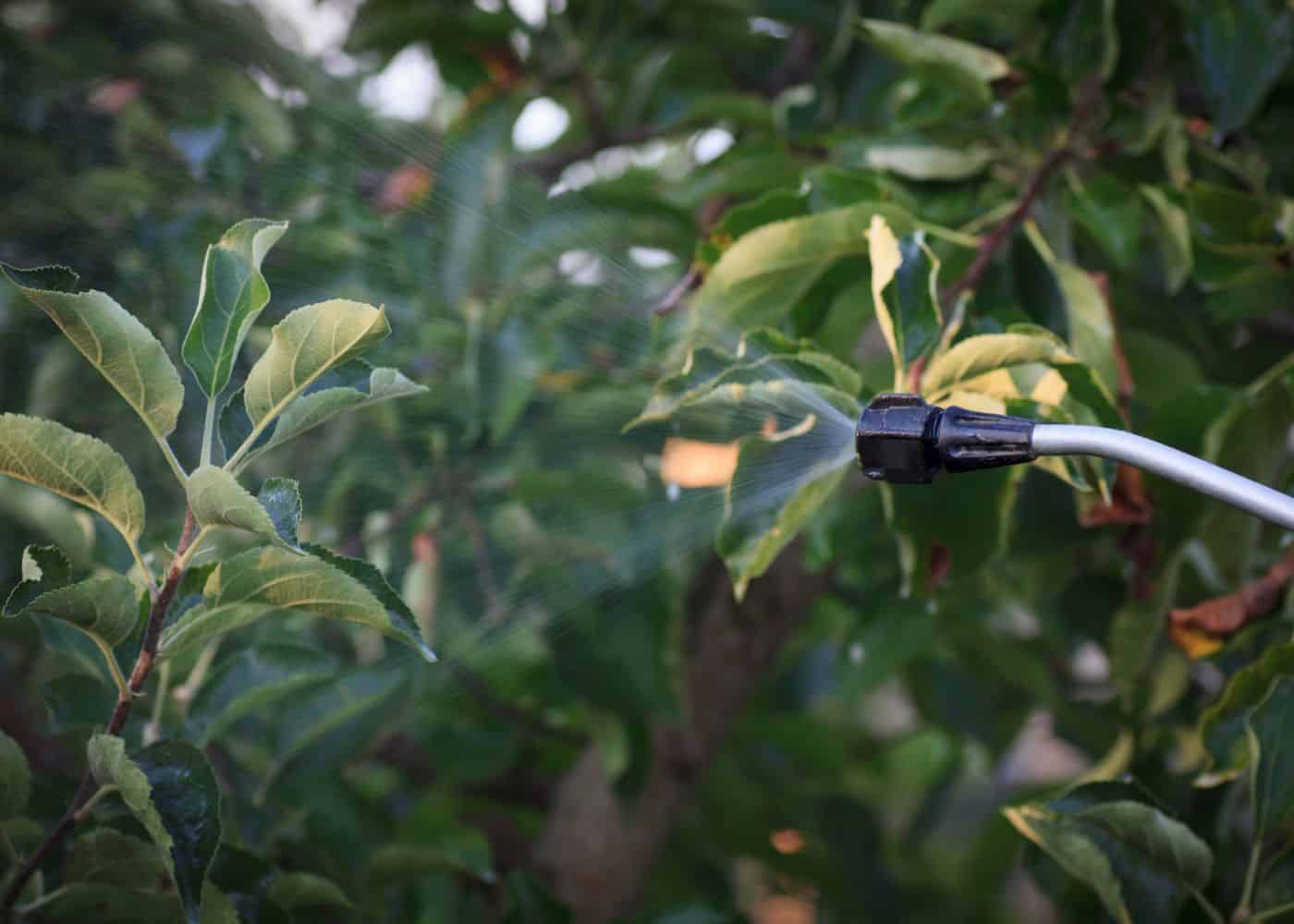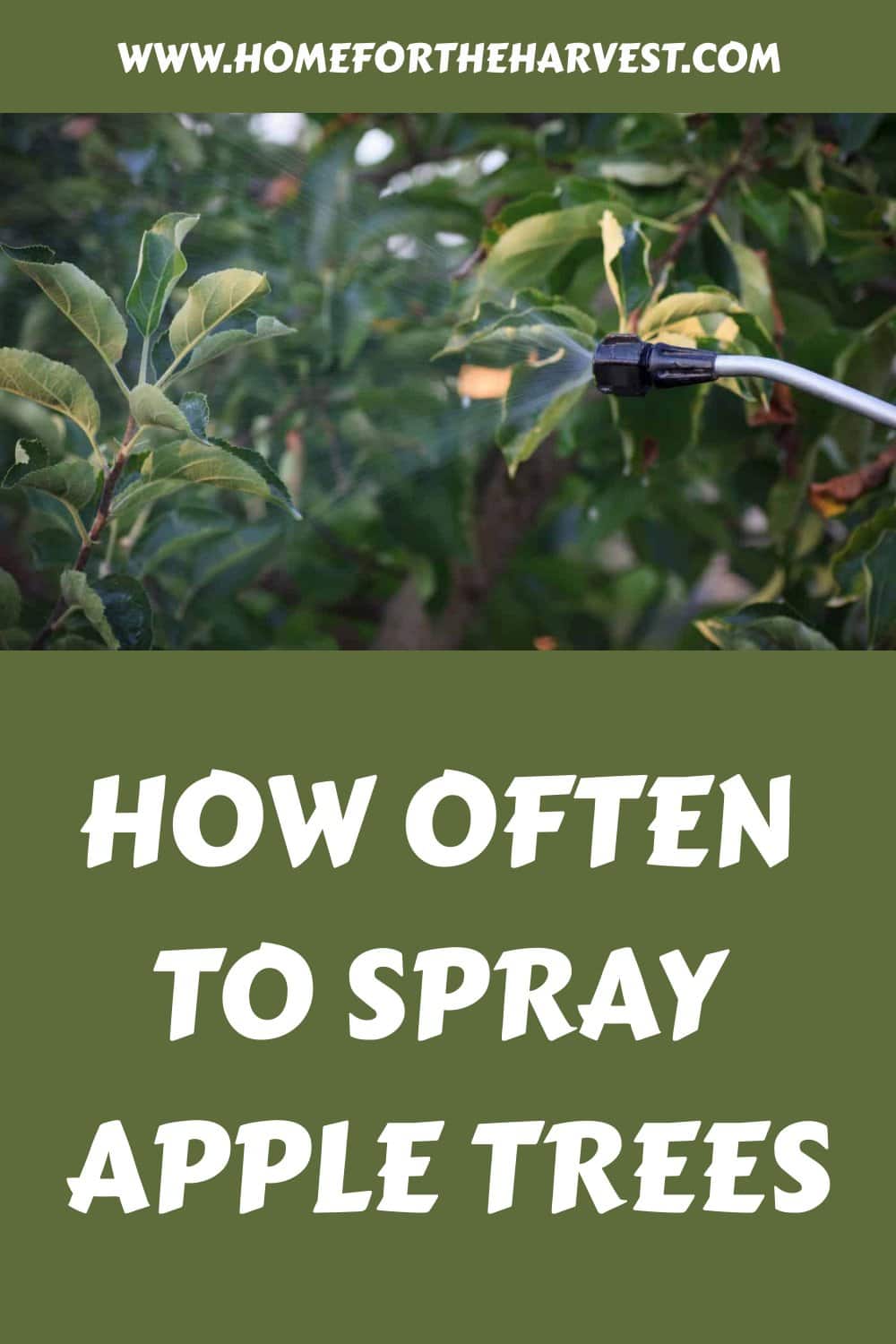Apple trees that require spraying are generally sprayed once in the winter, 1-3 times during flowering, and up to every week or two during the growing season if pests or diseases are a problem.
The winter spray is typically one application of horticultural dormant oil. During flower bud and blossoming, organic sulfur, neem oil, and/or Bt sprays may be applied for disease and pest control. After fruit set, organic pesticide and fungicide sprays may be applied up to every week or two. Stop spraying 30 days before the expected fruit harvest.
How often to spray apple trees
Apple trees are sprayed as often as they need to be to keep them healthy. This includes counteracting problem pests and common apple tree diseases.
A healthy apple tree growing in ideal climate conditions may not need to be sprayed at all. A similar tree growing in suboptimal conditions may need to be sprayed half a dozen times to get a decent harvest.
Here is a routine apple spraying frequency summary:
- Winter dormancy (often in March): spray with horticultural oil to control overwintering pests like scale, aphid eggs, and spider mite eggs, as well as some diseases.
- Spring swell of new emerging leaves (often in mid-April): spray with insecticidal soap or organic insecticides like neem oil for pests like aphids and mites. Some growers also spray with organic sulfur for disease prevention (although the timing of the sulfur spray must happen a minimum of three weeks after the dormant horticultural oil spray in late winter).
- Spring pink flower bud (often in late April or early May): Spray with insecticidal soap or organic insecticides like neem oil for pests like aphids and mites. Spray with Bt for pest caterpillars. Spray with organic sulfur for disease prevention.
- Spring blossom petal fall (often in mid-May): Spray with Bt for pest caterpillars. Spray with organic sulfur for disease prevention. Spray with kaolin clay spray for insect pests.
- Fruit set through summertime (often mid-May to mid-August): If disease is observed, spray every week or two with an organic fungicide like organic sulfur or Bordeaux. If insect pests are observed, spray every week or two with an organic insecticide like pyrethrum flower extract or spinosad. Stop all spraying 30 days before the expected harvest.
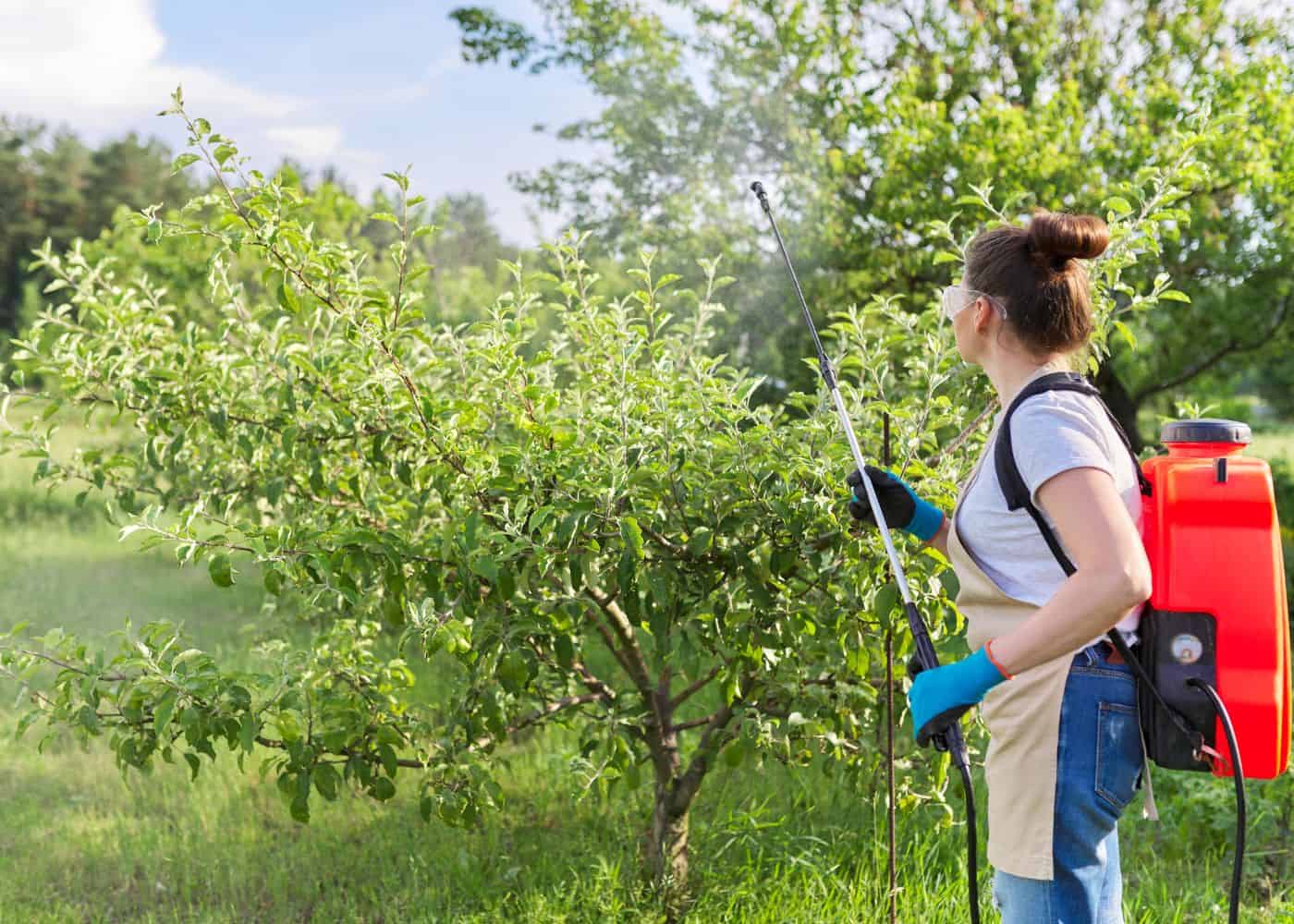
Common apple tree pests and diseases
Apple trees are prone to many different pests insects as well as pathogenic diseases. Here are some common pests and diseases that may require treatment with a horticultural spray.
Apple tree pests
- Coddling moth
- Apple maggot
- Plum curculio
- Apple sawfly
- Aphids
- Mites
- Scale
Apple tree diseases
- Fire blight
- Cedar apple rust
- Apple scab
See more common diseases here.
“The major insect pests of apple are plum curculio, apple maggot, and codling moth; the major diseases are fire blight, cedar apple rust, and scab. In general, these insect and disease problems are serious enough to necessitate spraying apples growing east of the Rocky Mountains.”
Landscaping with Fruit, by Lee Reich
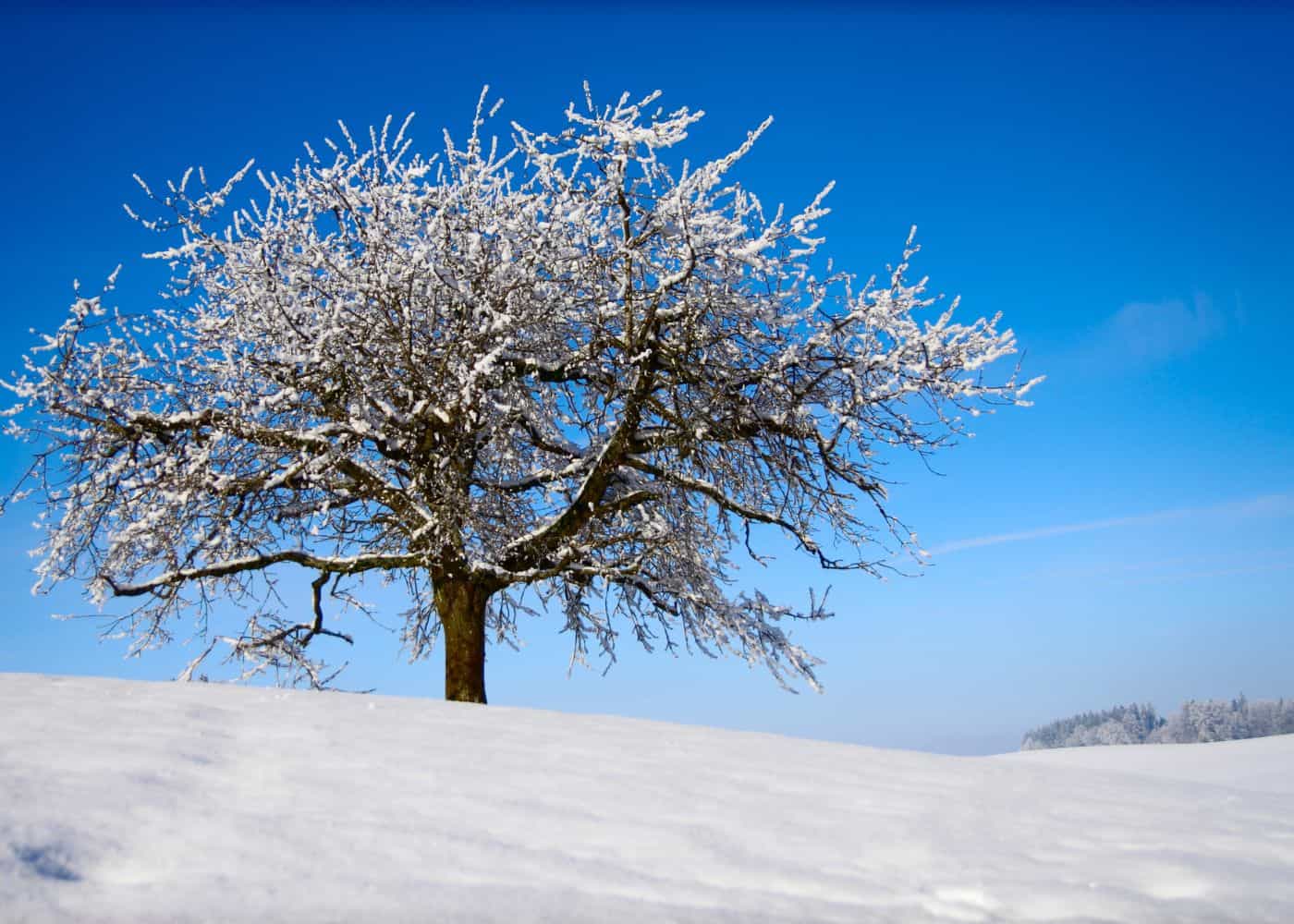
Winter dormancy apple tree spray schedule
Dormant oil is a horticultural spray applied at the end of an apple tree’s dormant winter period. Diluted oil is sprayed over the exposed branches and trunk, suffocating overwintering pest insects like scale, aphids, and spider mites as they wake up from their dormant period.
To be effective, dormant oil must be applied during the short period after these pest insects “wake up” and start to breathe, but before the tree starts to leaf out. This allows the spray to reach the branches and coat the pores of the pests. Applying dormant oil in mid-winter is not effective because the pest is not actively breathing so suffocating them will not destroy them.
Dormant oil is usually sprayed on apple trees in late March or early April. By this time, the warm late winter/early spring sun is starting to warm the trunk and branches and the long hours of daylight are encouraging the insects to start to respirate. Be sure to apply the dormant oil before the tree’s bud break occurs, indicating the tree has broken dormancy.
Spraying the spring swell of new emerging leaves
The next round of apple tree spraying occurs as the leaves are just emerging from the overwintered buds. This often occurs in mid-April, but the timing can vary from region to region and from year to year.
The buds first swell to a fuzzy silver – a stage called “Silver Tip”. Then the buds develop into “Green Tip” as the leaves start to emerge, and onto “Half-Inch Green” as a half-inch of the folded leaf is visible (also called “Mouse Ears”). The type of spray(s) applied depends upon the pests and diseases that are plaguing the tree or are common in the area.
For pest insects, home growers typically use natural sprays like insecticidal soap or neem oil. For disease prevention (as diseases are generally not observable yet), an organic fungicide like organic sulfur can be sprayed. Sulfur spray can’t be applied within 3 weeks of dormant oil spray, so plan accordingly.
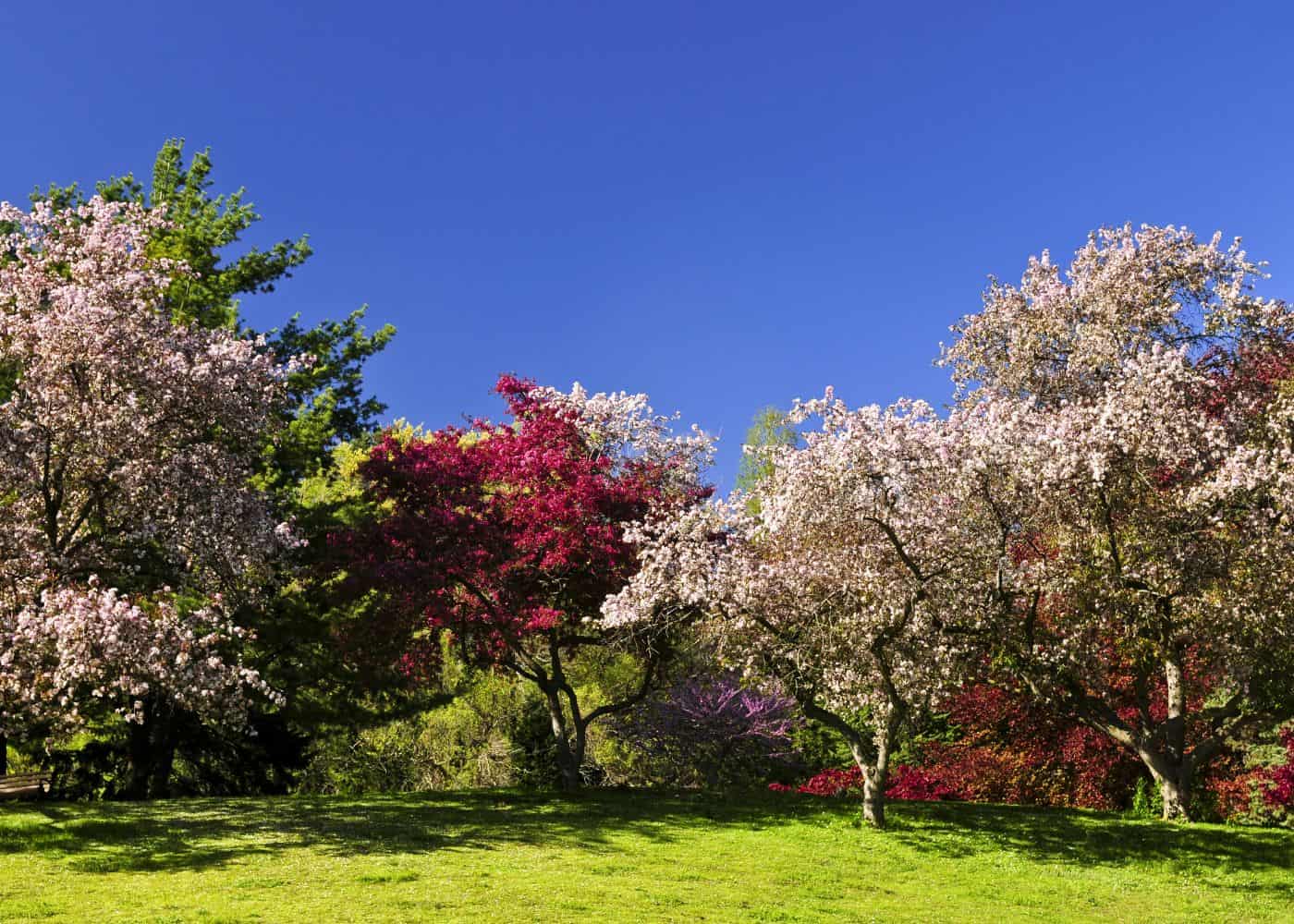
Spring flower bud and blossom spraying
Spraying during apple tree flower bud and blossom is common, but must be carefully considered concerning safeguarding beneficial pollinators. For this reason, many growers choose natural sprays and apply them before the flower buds bloom.
This occurs at a growth stage called “Tight Cluster” when the apple leaves have unfurled quite a bit but are still folded backward. The flower clusters are typically visible at this point amidst the emerging leaves. This is a good time to spray for diseases like apple scabs and powdery mildew before the pollinators arrive. Tight cluster typically occurs in late April but will vary by climate conditions and annual weather.
The time to spray fruit trees for some common pests is during “Pink Bud”. This is the growth stage when the flower buds are plump and pink but are still closed. Spraying right before the blossoms start to open can counteract pest insects and also provide another opportunity to spray for disease prevention (as during tight clusters, described above).
Here are commonly applied sprays during the pink bud stage of a fruit tree:
- Organic insecticides like neem oil for aphids, mites
- But for pest caterpillars like coddling moth
- Sulfur for prevention of fungal disease
The sprays listed above are only applied if that particular pest or disease is a problem. Sprays are not mixed and must be applied separately as part of fruit tree spray schedules.
Spraying while apple trees are blossoming
Apple trees are generally not sprayed while the flowers bloom. This is mainly to avoid any harmful effects on the beneficial pollinators that are needed to produce fruit, but also to avoid deterring the pollinators from the area and to avoid damaging the blossoms themselves and potentially affecting fruit formation.
Don’t apply fruit tree sprays once the first blossoms have opened (the King Blooms). Wait until the petal fall of 80% of the blossoms or more have completed their bloom period before resuming spraying.
Fruit set and summertime spraying
If a certain pest or disease is a problem, a regular spraying program can begin after the petal blossoms have fallen. This is the time to spray again with Bt for pest caterpillars and with kaolin clay spray for pest insects. If the disease is observable, you can also separately apply an organic fungicide like sulfur spray or Bordeaux spray.
Apple and pear trees with a specific threat condition may be sprayed per the application frequencies of the product (usually every week or two). This can include separate spray programs for different pests and diseases. Organic fungicides for the disease include organic sulfur or Bordeaux. Natural pesticides that can be applied throughout the growing season include pyrethrum flower extract. While pyrethrum is naturally derived, it is a broad-spectrum insecticide that can harm bees and other beneficial pollinators.
The start of summer (typically early July) is also when apple maggot flies emerge from the soil, ready to infect apples. These nasty critters lay their eggs inside developing apples, right under the skin. The maggots then hatch and feed for about a month inside the apples. The deformed apples then fall to the ground, allowing the maggot larvae to enter the soil and overwinter to repeat the process next year.
To counteract the apple maggot, hang traps that look like tasty red apples while spraying the real apple crop with kaolin clay spray. The clay will need to be reapplied to the apple surfaces after rainfall and as the apples grow wider. The clay physically repels the flies from the apples, while also disguising their attractive peel. Organic pesticides like spinosad may also help.
You can also set codling moth traps if codling moths are observed.
Stop all summer sprays 30 days before the expected harvest to avoid contaminating the crop. Remove any diseased developing fruit or foliage from the area as soon as observed.
Once harvest season arrives, take care to pick up any fallen apples daily and send them for hot composting in your municipal yard waste bin.
Fall apple tree spraying
Apple trees are typically not sprayed in the fall. Spraying stops in late summer 30 days before the expected apple harvest date. The trees are not sprayed during harvest and are left to drop their leaves on their own. Fallen foliage can be removed from the orchard area and composted to decrease overwintering disease and pests.
The next spray for the apple trees will be the dormant horticultural oil spray in late winter/early spring, right before the tree breaks dormancy.


